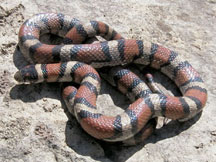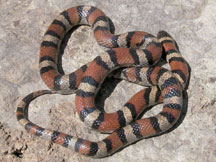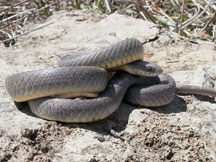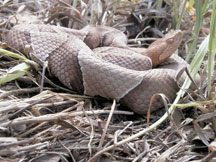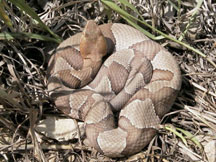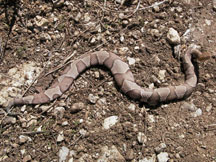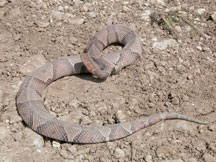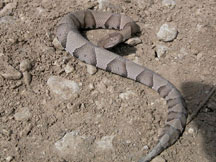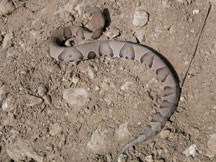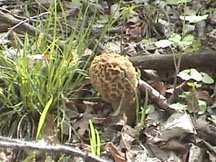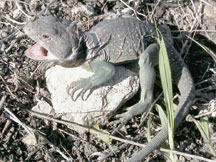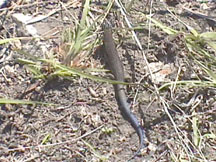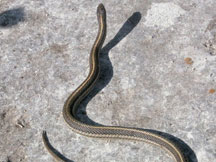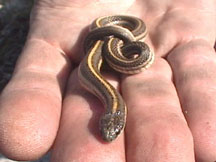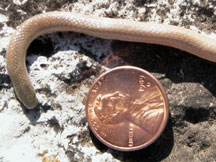
Kansas Herp Trip 2002
Thursday, May 2, 2002
Trip Details
Herpers: Jim Scharosch & Matt Ricklefs
Location: Wabaunsee County KS.
Time: 11:00 am
Temp/Conditions: Sunny. Not too windy. Started out at 63 degrees or so and made it to a high of about 72. Very good day overall.
Considering the day we had on Wednesday we were not expecting much for Thursday. Even the forecast was discouraging, which had been fairly accurate to this point. As plans do change however, Thursday become a welcome day that we had not planned on. We started out in an area that we had found Ringnecks and Great Plains Skinks at earlier in the week. We did find some Ringnecks, but this is a given at this point. We thought we would have done better. We were still not discouraged and had actually planned well this day once we saw the favorable weather. We had stopped at the county courthouse and obtained a county map. This is a very detailed map of the county including all the small roads, towns, etc. Using this we plotted a course that seemed to follow some small streams. In a perfect looking area right on the roadside we encountered in a small area of about forty yards. An extremely good example of herps maximized and taking advantage of a fairly isolated habitat on what was a very out of the way road. We found literally dozens of Ringnecks. Under the first rock Jim turned, we found a snake that had eluded us over the years in this area. The Central Plains/Red Milk Snake intergrade (Lampropeltis triangulum gentilis/syspila).
This was the very typical milk snake shape, but had the more defined ring-like markings. It was fabulous. Already, the day was paying off and we looked forward to more. After our normal allotment of pictures we released it back under its rock. Right above and to the left we found a Yellow-Bellied Racer.
This was obviously a good exposure and habitat as the other side of the road did not yield anything but a fleeing Skink and another Racer. I continued to look on this side so we could divide and conquer when I heard Jim yell, "Copperhead!".
The day had really paid off now and anything else we would find would be added bonuses. This was a real pretty one about twenty-two inches long. The green on the tail was still present. Juvenile Copperheads are born with about an inch of bright green on their tail. They sit in a coil and dangle this within reach of their heads. When a frog or other prey comes to get the green "worm" WH am. The baby Copperhead has a meal. This is called caudal luring, and is quite a neat adaptation. Many species of the Agikistrodon genus have this adaptation. Often times they carry the color into adulthood, but do lose the habit as once grown they do not need to rely on this tactic. This one may have shed recently as the colors were very vivid with the blends of salmon, orange and outlining white and brown. This particular species was the Osage Copperhead (Agkistrodon c. phaeogaster). As with the Western Massasauga these are usually not easy to hook, but this one was fairly cooperative. Most people think that when you turn rocks to find snakes they immediately shoot out or try to strike and bite. This is very much the opposite of what they do. Venomous snakes included. In the case of this Copperhead, once the rock was turned it did just sit there and we were able to take our footage of this "undisturbed" one. Once we have captured some more natural looking shots and document how it was found, then we pick it up for further documentation and observation. This really works well with two people and when studying venomous animals especially, but even generally it makes documenting easier. Actually when dealing with venomous animals you need to always have at least two people even if you have over ten years experience each as Jim and I do. It is just much safer, and you are in a much better position in the event of something unlikely happening. Once finished, you also need to put the rock, debris, etc. back the way you found it and then allow the snake or other animals to go back where they were. This helps with stress on the animal by allowing them to go back where they were and it also allows you to know where they are. That is why it is so important with venomous species. In the case with this one, it went toward the rock and then went into some grass and disappeared instantly. It was not that it was moving that fast, it's just that it is so camouflaged and familiar with the habitat that we instantly loss sight of it. With Rattlesnakes you can trace them. Copperheads however do not make this noise. We made sure we knew which direction it was in and went the other way. Moving down a little further we found a large rock that needed both of our efforts. Under it we found another Osage Copperhead.
This one was a bit longer at approximately thirty inches long. This one was much darker and dustier and more than likely had not been out of hibernation long and was still dirty from being under and not having shed yet either. This one was also a little feistier, but we also could not allow it to remain undisturbed as the rock was too big. This brings up a good point. When turning rocks or other objects to find herps, you NEED to take the time to look at the surroundings and find the best way to turn. When possible, you should turn the rock so that it is between you and the snake or other animal. This acts as a shield of sorts. Sometimes this is not always possible. Make sure you are prepared for anything and that you have a good hold on the object you turn. If you slip and drop it, and kill whatever is underneath you will not be happy, and it certainly does not do the animal any good either. Just be careful, cautious, and prepared. After a number of pictures of this Copperhead, we allowed this one to go under it rock once we got it back to where it was. As big as the rock was, it was not easy, but it is important. A little further and we found yet another Copperhead.
This one was a juvenile. It was about ten inches long. It had the bright green on the tail and the more grey coloration typical of young Copperheads. We followed the normal procedure and moved on. On the other side of the hill we did also find some huge Morels.
These were gathered and these were not left behind as is the practice when looking for herps. I guess the other difference is that we don't eat the herps either. Which is good. And so are Morels! This site we marked on our map of the area. We will continue to check this location as productive as it was. This was one of the best days we have had. At that point we moved on to find another location. One of which we had been to before.
On the road to the place we had been to years past which I will call "Memory Hill" we stopped on the roadside at a favorable spot. We found a nice Red-Sided Garter Snake and a Collared Lizard. The roadside was a typical washout with rocks scattered in the grass. Similar to the great spot we had just come from. We then carried on toward Memory Hill. I call it that because he had a heck of a time finding it. Both Jim and I had to strain our memory to remember exactly where it was. After some searching, we found it. Ten years had changed this quite a bit and we both had different remembrances of it. After some deliberation we were able to find enough landmarks to insure this was the spot. We spread out and searched the area. This is another good spot for Collared Lizards and indeed we did find our share up here. Jim and I both found large males which are quite impressive with a stunning green color and the massive jowls used for eating the various large insects and mice that populate the area.
Years ago we had seen the tenacity of the adult male by charging the camcorder. We had chased it and made it mad enough to turn and "say" THAT'S ENOUGH OF THAT YOU SILLY HUMANS!! He actually bit at the camera and was quite adamant to stand his ground. I tried this experiment again and was foolish enough to put my finger in range. It took a few minutes for me to get Jim's attention to assist me with removing this noble creature from my finger. We carefully tried to pry him off. It really didn't hurt too much until his jaws hit my cuticle. That hurt. Jim was finally able to get enough leverage to carefully open his mouth and get him to let go. He stood his ground for a few minutes and finally scurried on his was in the fashion that they do. We also found a juvenile Great Plains Skink which looks similar to the adults in pattern, but the color is much darker becoming more black and dark brown with a beautiful indigo colored tail.
After we properly documented this juvenile we let it go on it's way and moved up the hill where we had found some Lined Snakes in the past.
Sure enough, at the top of the hill where there was a jutting out of rocks in a picturesque setting we found a Lined Snake (Tropidoclonion lineatum).
I was just walking along and nudged a rock with my foot decided to flip it and there it was. These are very cool little snakes and I always look forward to finding them. In the right area they can be pretty common, it just takes some patience to flip the small rocks to find them. On the way back we noticed several areas where mice were jumping around from rock to rock. We have not found any large snakes to this point in these areas, but I would imagine in the right area with this food source they would do very well. We walked back to the van and left Memory Hill. We will go back next year and see what has changed.
On our way to Kansas earlier in the week, we stopped to get gas at a small gas station in a small town. The service was "self" and the atmosphere inside was quaint and friendly. Upon paying we noticed a small box of knifes. As those who are reading may or may not know, guys usually like knifes. Being the guys we are, we do. With careful scrutiny we looked them over. The prices were reasonable and the knifes were fairly good quality considering they were in the small gas station off the highway and away from anything else. All we really wanted was a couple of work knifes that we could carry for whatever reason. As much just to have a cool knife at our sides. Kinda silly, but I guess it is just something from growing up. Knifes = cool. We both picked one to our liking and went on our way...Now, back to May 2nd. Only a day and a half after getting the knife, I lost it. At the time of purchase, I considered that this may happen and thought I was prepared. On May 2nd I decided that I knew where that knife "HAD" to have been lost and insisted that we return to Weather Station Hill where we had found Collared Lizards on that windy day at the onset of the trip. After I convinced Jim, we went back to the hill and we searched. And we searched. I went all over that darned hill and believe it or not I could not find that knife. I look back now and consider how folly this was. I guess I did NOT know where it was. Jim did find something else however, a Flathead Snake (Tantilla gracilis).
So the trek was not a loss. This is a very small snake. This one was approximately 6 inches long, and at that size was an adult. In the pictures we placed a penny to show the scale. Big snakes are cool to find, but these small snakes are just as cool. They are very unique and it is lucky to find them. After the normal amount of pictures, we set it on it's way. It was getting late and it had been a very successful day of herpin. It is nice to find things as we did this day. You will always remember these days and it is amazing the detail you can remember. Don't forget that any time you have a chance to get out, it is good. We like herps, but there is so much more to see, hear, smell and feel, especially in another state. Take time to look around. Nature's variety is all around. There are birds, mammals, insects, spiders and of course herps of all kinds. Consider yourself fortunate to be a part of these things, even when you don't have a "good day" of finding what you are looking for. I recently started reading "Snakes and Snake Hunting" again by Carl Kauffeld. This is an excellent book of "snake adventures". He reiterates the sheer pleasure of just getting out. There are also a lot of good stories that many of us will be able to relate to. So, take the good days and the bad days in stride and remember that when we are out, we are part of a big picture that many seldom get to see in the detail we do.
Happy herpin'!!


